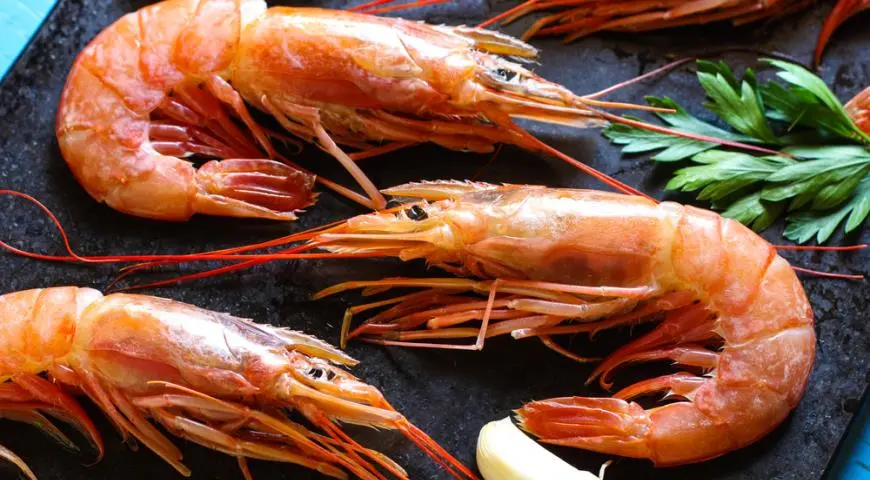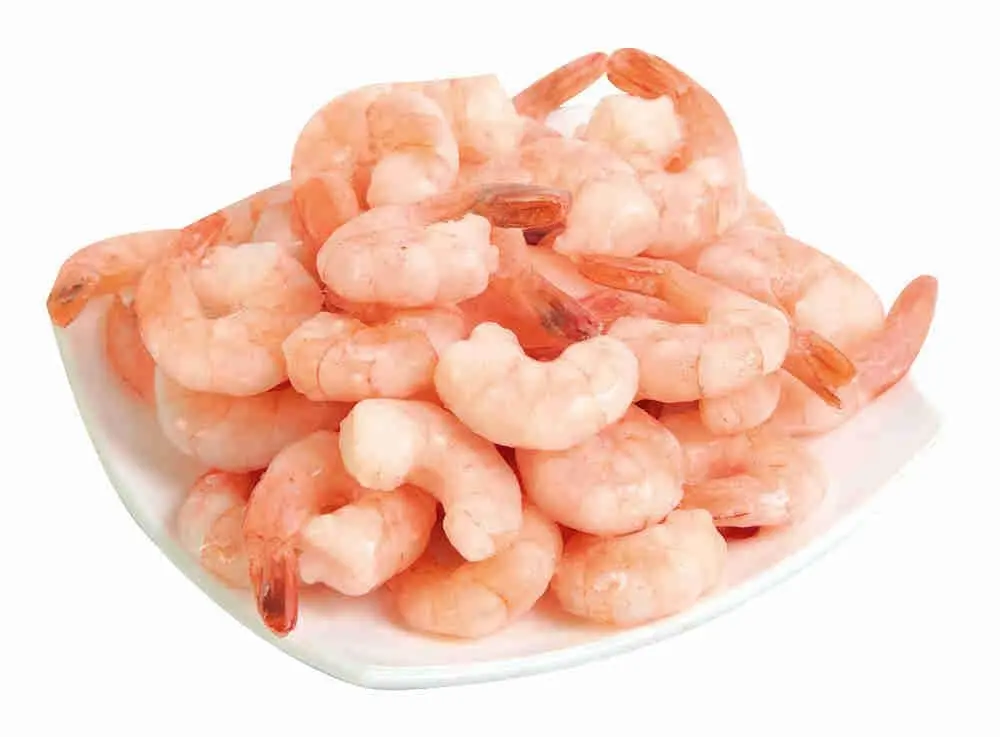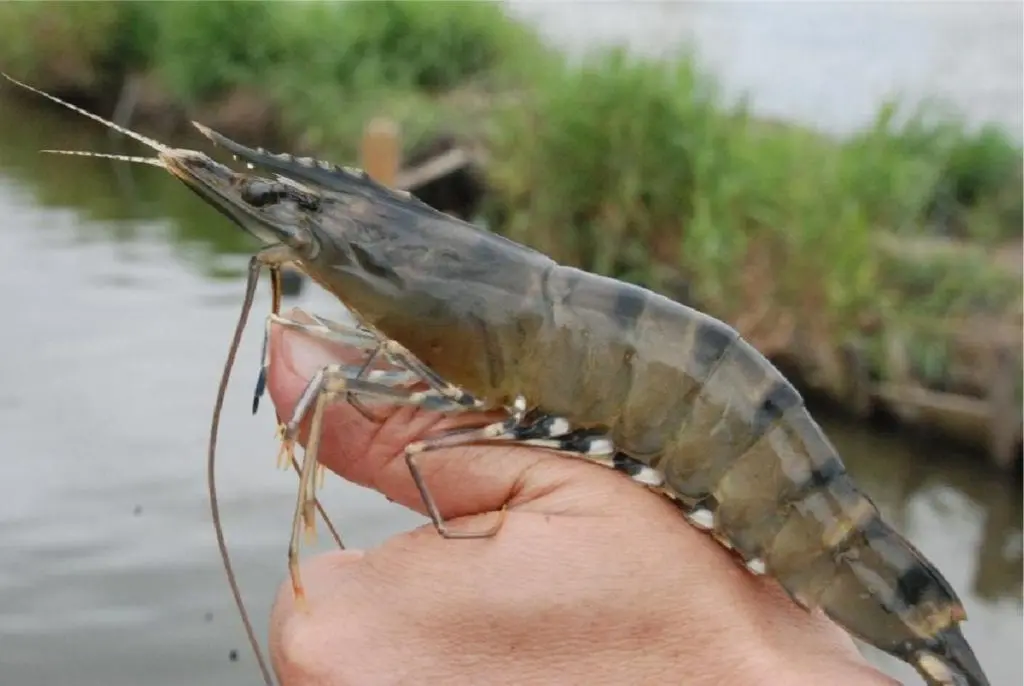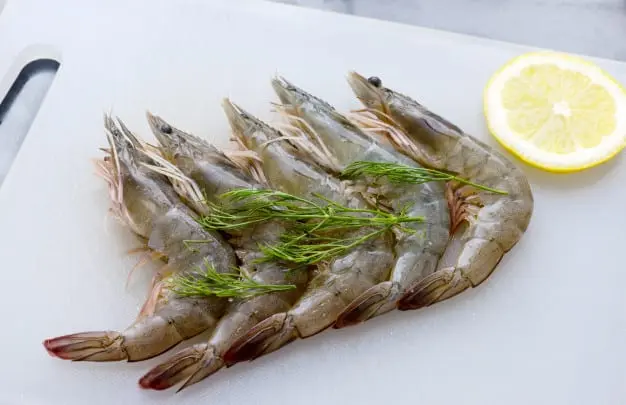Contents
- Description
- Composition and calorie content
- Shrimp types
- Useful properties of shrimp
- The benefits of shrimp for women and men
- Shrimp for the elderly
- Is it possible to eat shrimp for pregnant and lactating
- Is it possible to give shrimp to children and at what age
- Contraindications
- Shrimp harm
- Taste qualities
- Cooking applications
- How to boil shrimp properly
Description
Shrimp has long passed from the rank of delicacies, available only to a few, into a generally available product. Frozen, chilled, peeled, in a shell – all these types of products can be seen today in almost any store. At the same time, the benefits of shrimp are quite comparable to the benefits of exotic and expensive lobsters, lobsters, crabs, etc.
Shrimp is not only a wonderful snack, but also a component of almost every low-calorie diet. Boiled and fried shrimps are added to salads, soups, side dishes and served simply as a separate dish.
Composition and calorie content
Shrimp, like all seafood delicacies, is a storehouse of valuable protein. The concentration of useful micro- and macroelements in shrimp is ten times higher than in meat. So, shrimp contains sodium, potassium, phosphorus, sulfur, calcium, magnesium, iron, zinc, copper, manganese, iodine, fluorine, chromium, cobalt, nickel, molybdenum, etc. This good half of the periodic table saturates our body with a huge supply of vital energy.
In addition to mineral saturation, shrimp meat is also rich in vitamin composition: vitamins E, C, PP, B1, B2, B3, B6, B9, B12, A, H.
The calorie content of shrimp is about 90 kcal per 100 g of product.
Shrimp types

Shrimp are divided into warm water and cold water species. The former are found in tropical zones, and the largest of them are royal. They are abundant in the coastal waters of Thailand, the Caribbean, and Vietnam. Cold water are found in the northern seas. In particular, there are many of them off the coasts of Norway, Canada, Estonia.
There are also tiger prawns, which have a higher meat yield than most other species. However, no matter which species you buy, the benefits of shrimp are equally great.
Useful properties of shrimp
Shrimp is a pretty versatile product. They can be used as a separate dish, salads and soups are made from them, they are added to pizza. They go perfectly with lime and rice. What is the secret of shrimp popularity?
In addition to its excellent taste, shrimp has a unique chemical composition. First, they are rich in valuable proteins, one of which stimulates the production of collagen in the body. This substance determines the condition of our skin: it is thanks to collagen that it acquires a healthy appearance and elasticity. Read about other products that keep skin youthful here.
Moreover, each shrimp is a true multivitamin complex. Believe it or not, it contains vitamins A, B, C, D and E. Thanks to this, the body strengthens its immunity, the skin, hair and nails become healthier, and the work of the digestive and cardiovascular systems improves.

Besides vitamins, shrimp are also rich in beneficial minerals. We are talking about potassium, magnesium, calcium, phosphorus, acids and many metals necessary for the body. Shrimp is especially rich in iodine, which is an indispensable element for the normal functioning of the thyroid gland. At the same time, shrimp are low in calories, so doctors are very fond of including this product in all kinds of diets.
Another characteristic feature of shrimp is the almost complete absence of contraindications to their use. An exception may be individual intolerance. It is still not known about any serious complications associated with their use in food.
The benefits of shrimp for women and men
For certain groups of people, shrimp is especially necessary. For example, for pregnant women. Seafood in general and shrimp in particular are beneficial for promoting a healthy circulatory system in the fetus. They are also useful for nursing mothers and their children, as they prevent the appearance of cancer in the future.
It should be noted that shrimp in general has a very beneficial effect both on the health of expectant mothers and on the development of the fetus. But pregnant women should not abuse this product. To find out the optimal amount of shrimp to eat, it is best to consult your doctor.
In general, shrimp is essential for women as it improves their appearance and well-being. In addition, they normalize the body’s hormones. For men, shrimp is a powerful source of potency for them. The fact is that the selenium and zinc contained in them stimulate the production of the male hormone testosterone.

Scientists have long noted the beneficial effects of shrimp on allergy sufferers. They noticeably reduce allergic reactions to other foods, while they themselves are almost harmless from this point of view – allergies to shrimp are recorded extremely rarely.
With moderate consumption, the benefits of shrimp for the human body are obvious. But it is worth remembering that an important factor when choosing shrimp is their habitat. If they are caught in clean regions or grown on a farm without the use of hormones and other growth stimulants, shrimp will be 100% beneficial.
Therefore, when buying, pay attention to the manufacturer: it is better to give preference to well-known and trusted companies. Shrimp is one of those foods that you shouldn’t skimp on. If you want to get the most out of your shrimp, focus on quality rather than price.
Shrimp for the elderly
The health benefits and harms of shrimp for older adults are controversial.
Product in small quantities:
- strengthens bones;
- protects against infections;
- normalizes cholesterol levels;
- stabilizes pressure.
That is, arthropod meat will help to cope with most of the problems typical for a certain age, if there are no contraindications from the attending physician caused by the properties and composition of seafood or individual intolerance.
Is it possible to eat shrimp for pregnant and lactating

Shrimp: benefits and harms for the body, beneficial and harmful properties for men
Pregnant and lactating women should be especially careful about quality nutrition. Nutritionists insist on the benefits of seafood and its weekly use by this category of people. During both pregnancy and lactation, vitamins and polyunsaturated acids strengthen the mother’s body, stimulating the development of the fetus and the correct growth of the baby.
Is it possible to give shrimp to children and at what age
Pediatricians’ opinions on the benefits of shrimp in the diet of children differ only regarding the age when the product can be included in the diet. Most of them insist on 3-4 years, and then the portions of the baby should be increased gradually.
For the first time, after consulting a pediatrician or doctor, a child should taste one shrimp, being supervised for at least a day after that.
The privilege comes into force in the city of Kiev! From September 29, every man has a free
More details
The harm caused by crustaceans is evidenced by:
- sudden loose stools;
- labored breathing;
- the appearance of rashes;
- causeless rhinitis.
If there are no contraindications of the doctor and an allergic reaction, after reaching the age of 5, the child is allowed to give no more than 30-50 g of shrimp per day, which is equivalent to eating 100 g of fish or veal.

The teen’s portion is increased to 70–80 g. The dishes prepared for children are flavored with sour cream sauce or lemon, but not with spices, because of which their properties are enhanced and can harm the child.
Contraindications
The composition of beneficial crustaceans contains a unique antioxidant astaxanthin, which exceeds the effectiveness of similar substances found in fruits. It protects the body from premature age-related destruction, neutralizes stress, and helps in the treatment of arthritis, gout, rheumatism and other common diseases.
Moreover, the benefits of king prawns and not so large specimens are the same.
With diabetes mellitus
It is recommended for people suffering from diabetes to eat shrimp. Iodine from arthropod meat will strengthen the body and help the internal organs to function properly.
The dietary product is easily digested, cleanses the body of food waste, toxins.
A daily portion of shrimp should not exceed 100 g, since the abundance of cholesterol in combination with minerals can neutralize the effects of medications taken, causing harm to health.
With pancreatitis

Shrimp: benefits and harms for the body, beneficial and harmful properties for men
Treatment of the pancreas is inextricably linked with adherence to a strict diet, certain dietary restrictions. During an exacerbation of pancreatitis, it is better to refuse marine crustaceans. After the normalization of the indicators, the diet is replenished with useful shrimps as an ingredient in cutlets, soufflé, and soup-puree.
With gastritis and stomach ulcers
The reasons that force you to refuse treats with stomach ulcers or gastritis due to the harm they cause are:
- exacerbation of the disease;
- increased acidity;
- allergic reaction;
- improper preparation.
Only boiled shrimp will benefit, served without excess salt, spices, lemon juice, which will irritate the walls of the stomach and increase the secretion of gastric juice. Served in a salad with boiled peas, a variety of vegetables, steamed or boiled shrimps, due to their properties, will only bring benefits.
Shrimp harm
Like any healthy seafood, crustaceans can be harmful if consumed in excessive amounts. The danger is posed by cholesterol and heavy metals, which are increasing in sea waters every year.

Many people suffer from seafood intolerance due to an excess of protein in them, which leads to problems with the digestive tract, allergic rashes.
Shrimps grown on private farms, where hormonal drugs, growth stimulants, and antibiotics are used to achieve a quick result, can cause particular harm.
Taste qualities
Shrimp meat has a pleasant sweetish taste characteristic of crustaceans and a bright iodine aroma. Shrimps are much juicier and more tender than the larger members of the family. Among the types of shrimp offered by the trade, the most valuable are crustaceans subjected to shock freezing. This technology allows you to preserve the maximum amount of benefits inherent in nature in meat.
Too long exposure of the crustaceans to boiling water leads to the fact that the meat becomes tough, losing both taste and aroma. Quality shrimp meat is firm but not tough. There is juice in the fabrics, and notes of sea and algae are mixed with the sweetish smell.
Cooking applications

Shrimp is also used as an independent dish, and is included in a wide variety of salads, appetizers and soups. They are added to risotto and pasta, baked with cheese and sauce, grilled and boiled with herbs and spices. The options for cooking shrimp are incredible.
Particularly interesting recipes appear in coastal countries, where shrimp are most readily available. So, in Italy, along with mussels, shells and fish, shrimp meat is an indispensable ingredient in pasta, pizza and risotto. Here shrimp are combined with rucola and cheese, garlic and oregano, basil and olives. The Spaniards, in love with shrimp, keep up with their neighbors. True, large crustaceans are preferred here, which are fried and served with vegetables or other seafood.
Shrimp are especially popular in Japan. Without these inhabitants of fresh and sea waters, one cannot imagine the most delicious nigiri-sushi, oshi-zushi and a number of other national dishes. Shrimp is served with pickled ginger, noodles and soy sauce, fried in sesame and spice breading. Shrimps in batter are extremely loved, where fragrant tender meat is hidden under a thin layer of crispy dough. Yozenabe is made from crustaceans and chicken – an appetizing and very satisfying roast.
How to boil shrimp properly

Shrimp is a delicious and healthy seafood with delicious dietary meat. They cook easily and quickly, the main thing is to know some of the nuances, and then it will not be difficult to cook a seafood treat!
1. Defrosting is required
Frozen seafood – you must first defrost them, because if they are immediately thrown into boiling water from the freezer, they will cook unevenly. We offer you 2 ways to properly defrost:
Option 1: on a shelf in the refrigerator, and then at room temperature
Option 2: pouring with cool water
2. Only fresh frozen product is cooked
Boiled-frozen shrimps are ready to eat: they are cooked in sea water on board a fishing boat, so they are eaten simply by defrosting. And scalding with hot brine will help warm up and add a spicy aroma.
3. To clean or not to clean?
Of course, shrimps cooked unpeeled are tastier and more aromatic: firstly, the heads and shells make the broth richer, and the crustaceans acquire a unique taste and aroma, and secondly, a layer of chitin protects tender meat from excess salt, keeping it soft and slightly sweet. …
4. Do not digest!
It is important not to expose the delicacy to prolonged heat exposure so that the meat does not lose its tenderness and juiciness. Small shrimps take a minute, medium 1-2, and large ones need 2-3, depending on the size. At the same time, the cooking time is usually considered not from the moment the water boils, but from the moment the shrimp is thrown in. Many people make a mistake: fearing not to cook the product, they increase the cooking time – but since the cooling does not happen instantly, the protein continues to fold for some time. To stop the process, place the cooked shrimp briefly on ice.
By the way, some fresh-frozen shrimps, such as Botan and Ama Ebi, are eaten raw by gourmets, only defrosting and, if necessary, scalding with brine in order to fully enjoy their unique taste, untouched by heat treatment.
5. More taste!
The classic of the genre is cooking in sea water, and in its absence – in ordinary water, with the addition of sea salt. For peeled shrimp, put 1 tablespoon per 1 liter, for unpeeled – 1.5, and the volume of water is taken twice as much as seafood. Spices will help to add more taste and aroma: dill, cloves, allspice, coriander, laurel, garlic, ginger or special seasonings for seafood – it all depends on individual taste preferences. A slight sourness is easy to achieve by adding half a lemon or a couple of tablespoons of tomato paste to the brine.
And actually, here it is – a perfectly simple and incredibly easy recipe for boiled shrimp:
- Defrost fresh frozen shrimps
- Boil water, add salt and spices to taste
- Dip crustaceans into boiling brine and cook for 1 to 5 minutes
- Serve and enjoy perfectly cooked shrimp!










